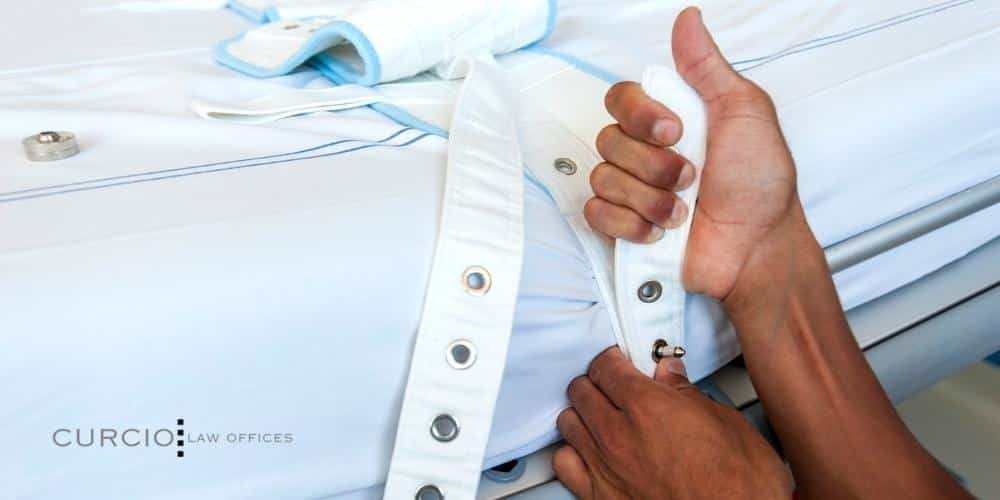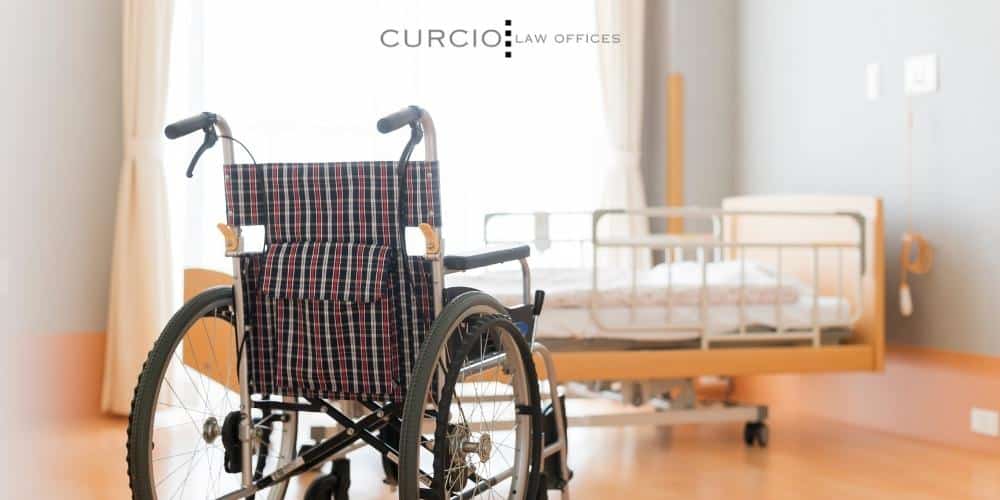CHICAGO UNREASONABLE RESTRAINT LAWYERS
PRACTICE AREAS
Unreasonable Restraint in Nursing Homes
Nursing home restraints were widely used against elderly patients before the Nursing Home Reform Act (NHRA) was passed in 1987. The use of physical or chemical restraints was designed to limit the patient’s normal access to movement and their own body. Eventually, people realized that nursing home residents were suffering a long list of health consequences due to chemical and physical restraints, which led to the creation of the NHRA. Other countries, such as the United Kingdom, took the issue a step further and greatly restricted or banned the use of physical restraints in nursing homes altogether. In the U.S., though, unreasonable restraint in nursing homes still occurs daily. An unreasonable chemical or physical restraint can lead to serious injuries, illnesses, and even wrongful death.
If your elderly loved one has endured significant pain and suffering due to a chemical or physical restraint in a Chicago nursing home, you have grounds to pursue legal action.
A seasoned Chicago nursing home abuse lawyer at Curcio & Casciato wants to protect the rights of your nursing home resident in Illinois. Allow our team of Chicago elderly abuse attorneys to fight for your loved one’s justice. Call us today at 312-321-1111 to schedule a free consultation.

What is Unreasonable Restraint in Nursing Homes?
Unreasonable restraint in nursing homes is any device or medication that’s used against nursing home residents in order to restrict his or her freedom of movement. Restricting a person’s free body movement for prolonged periods – whether that be through chemical or physical restraints – comes with a host of harmful effects. Although there have been numerous measures taken in the last few decades to reduce this type of nursing home abuse, thousands of elderly patients are still chemically and physically restrained every year.
Physical Restraints in Nursing Homes
There are two main types of unreasonable restraints: physical and chemical. Physical restraints are generally described as medical devices that are attached to a person’s body in order to prevent them from moving. Examples of physical restraints include:
- Arm restraints
- Leg restraints
- Vests and soft ties
- Bedrails
- Hook and loop fasteners on a person’s clothes
- Hand mitts
- Lap trays
- Brakes and bars on wheelchairs
- A bed sheet that is tucked in too tightly
Nursing home staff may resort to physical restraint use if a resident becomes a danger to themselves or others, has cognitive disabilities (e.g., Alzheimer’s disease) that makes them more likely to move around and hurt themselves, has a history of nursing home falls, has a history of agitated behavior, etc.
However, nursing homes should complete a fall risk assessment for high-risk patients, and often, this can be avoided without draconian measures if Chicago nursing home understaffing isn’t to blame. Our Chicago nursing home falls attorney can explain your options.
Chemical Restraints in Nursing Homes
Psychoactive drugs and sedatives are considered chemical restraints. Just like physical restraints, use of chemical restraints are designed to greatly limit someone’s personal freedom. Nursing home staff may use a chemical restraint if residents are hyperactive, dangerous to themselves or others, or incredibly anxious.
Overmedication of nursing home residents is never the answer to understaffing in nursing homes. Our Chicago medication error lawyer can help your family pursue justice if your loved one is a victim on chemical restraints in a Chicago nursing home.
When are Restraints in Nursing Homes Justified?
Both chemical and physical restraints should only be used in certain circumstances. Because these restraints are often referred to as medical devices, they should only be used for medical reasons.
So, if a patient has a medical condition that requires them to stay still for whatever reason, the doctor must explicitly state that in their treatment plan. The doctor must also provide nursing home staff specific instructions about physical restraint use, including how long the medical device must be used.
Nursing home residents have rights, too, including the right to consent to their health care, so doctors and staff members must provide informed consent to the patient about how the use of physical restraints would treat their medical symptoms. If the patient has cognitive disabilities, the doctors and staff members must seek informed consent from the resident’s family.
The same thing goes for a chemical restraint. Doctors must specifically authorize restraints for distressed or psychiatric patients. They must explain to the patient or their family how the chemical restraint benefits outweigh the detriments. Additionally, doctors and nursing home staff must seek informed consent from either the patient or the family before they begin chemical restraint for a medical reason.
If restraints are necessary for any medical reason, doctors and nursing home staff must do everything they can to keep the patient content, comfortable, and healthy. Additionally, they must take extra steps to protect the patient’s bodily autonomy.
What are Examples of Inappropriate Use of Restraint in Nursing Homes?
The health care team in a nursing home cannot use a chemical or physical restraint to:
- Punish an elderly patient
- Control an elderly patient
- Create a more “low maintenance” elderly patient
If a nursing home staff member resorts to the use of physical or chemical restraints for any of those reasons, they can be held liable in an elder abuse lawsuit in Illinois.
Additionally, if restraints are necessary for a medical condition but the health care team fails to keep the patient content, comfortable, healthy, and feeling as though their bodily autonomy is respected, then a family member could step in and file a lawsuit. If this sounds like your elderly loved one’s current situation, allow a Chicago nursing home abuse lawyer at Curcio & Casciato to fight for their rights.
Nursing Home Reform Act (NHRA)
As stated previously, nursing home residents have rights, just like the rest of us. The Nursing Home Reform Act of 1987 provides a strict set of medical ethics for elderly people. The law mandates that all nursing home residents receive high quality care that promotes optimum physical, mental, and psychosocial health. This law was originally created because, tragically, nursing home residents were being neglected and abused at high rates. This abuse frequently included use of physical restraints and chemical restraints in order to control “high maintenance” patients.
Under this law, all nursing home residents have the right to:
- Freedom from nursing home abuse and neglect
- Freedom from being chemically or physically restrained
- Privacy
- Engage in family and resident activities
- Receive accommodations for physical, mental, medical, and social needs
- Receive dignified treatment from staff members
- Communicate however they please
- Be self-determined
- Provide full consent to every medical decision
- Receive updates about their health care plan
- Speak out against abuse, neglect, or general maltreatment without fear of retaliation or discrimination from staff members
If nursing homes are caught violating one of their residents’ rights, they can certainly face an elder abuse lawsuit.

How Common is Unreasonable Restraint in Nursing Homes?
Even with all these laws in place, reported use of physical restraints in U.S. nursing homes goes up to 85% according to a 2006 study. The most common type of physical restraint used against nursing home residents across the globe are bed rails. In fact, a 2017 article states that up to 70% of worldwide nursing home residents are restrained by bed rails. Physical restraint use leads to a higher risk of serious injuries, illness, and early death.
How Many Deaths Occur Due to Unreasonable Restraint Use in Nursing Homes?
Approximately 174 deaths occurred due to the use of physical restraints in nursing homes according to a 2018 cross-sectional study. The most common cause of death in this study was mechanical asphyxia and neck compression.
More deaths may have occurred in the U.S. due to restraint use. However, some negligent staff members have been known to lie about the cause of death in nursing homes. Therefore, some families never know how their elderly loved ones actually died, whether it be from natural causes or nursing home abuse.
If your loved one died because of unreasonable restraint in a nursing home, contact our Chicago nursing home wrongful death lawyer.
Health Risks of Unreasonable Restraint in Nursing Homes
For many years, there was a common misconception that use of restraints on elderly patients kept them safe from all harm. This could not be further from the truth. Unreasonably restrained patients have high risks of all sorts of physical, mental, and medical issues.
Physical Health Risks for Unreasonable Restraint in Nursing Homes
Potential risks of physical restraints in nursing homes include:
- Severe bruising or lacerations from the patient trying to escape restraints
- Choking or suffocation from improper use of a physical restraint or from attempted escape
- Bed sores
- Muscle atrophy and weakness
- Malnutrition
- Constipation
- Urinary incontinence and UTI’s
- Difficulty breathing
- Decreased cardiovascular endurance
- Increased dependence in almost every aspect of daily living (eating, using the bathroom, bathing, etc.)
- Death from strangulation, a traumatic brain injury (TBI), broken bones, etc.
At Curcio & Casciato, we have several types of Chicago nursing home infections lawyers: Chicago nursing home bedsores attorney, Chicago nursing home UTI lawyer, Chicago MRSA lawyer, Chicago nursing home sepsis attorney, and lawyers for neglecting a diabetes nursing care plan.
Mental Health Risks for Unreasonable Restraint in Nursing Homes
Mental health risk factors associated with the use of physical and chemical restraints include:
- Increased anxiety, depression, panic, hopelessness, loneliness, shame, or agitation
- Post-traumatic stress disorder (PTSD)
- A feeling of a loss of control, loss of identity, loss of self-respect, etc.
- Increased fatigue or excess sleeping from sedation
- Disassociation, confusion, disillusionment
The same 2006 study linked above states that the potential health risks have less to do with the type of restraint being used and more with the current physical and mental condition of the resident. A physically or mentally unwell elderly person has a higher risk of suffering serious injuries and other side effects from restraint use compared to younger and healthier people.
For example, let’s say staff members resort to physical restraint use in order to prevent a frail resident from falling and injuring themselves. Many studies show that physical restraint may actually create more fall injuries. That’s because the elderly person will become frustrated with having various equipment attached to their body, so they may thrash and pull and fight until they do fall down.
Damages for Chemical and Physical Restraints in Nursing Homes
A family member can file an elder abuse lawsuit on behalf of their restrained loved one and potentially recover compensation for the following damages:
- Medical expenses associated with chemical and physical restraint injuries/illnesses
- Physical therapy expenses if the restraint injury resulted in some disability
- Physical pain and suffering
- Emotional distress
- Punitive damages
- Funeral and burial expenses if the use of restraints resulted in wrongful death
Chicago nursing home abuse attorneys at Curcio & Casciato have won more than $500,000 in settlements on behalf of our elderly clients. We have what it takes to fight for you and your loved one in a court of law.
Alternative Methods for Chemical and Physical Restraints in Nursing Homes
In most cases, a chemical or physical restraint as treatment for a medical problem should be avoided, especially if it will cause more harm to the patient. There are plenty of other methods that a health care team can implement, including:
- Make the patient’s room safer and more accessible by lowering their bed, placing a mattress on the floor, providing protective floor coverings, providing appropriate footwear and walking aids, and providing bed or chair alarms
- Create a comfortable environment by minimizing sensory overload
- Encouraging adequate communication with the patient so they can discuss their wants and needs
- Regularly communicating with the patient about their health care plan
- Documenting and analyzing patient behavior
- Encouraging family members to visit more often and engage in activities with the patient
- Encouraging patients to engage in both physical activity and rest
- Ensuring that the patient receives adequate nutrition and hydration
- Ensuring that the patient’s medications aren’t raising their fall risk through side effects like dizziness, for example
- Prescribing only necessary medications
- Managing the patient’s pain and discomfort
- Ensuring that the patient has daily cognitive stimulation
- Assisting the patient with going to the bathroom
Every nursing home should take all these measures, and more, before resorting to a chemical or physical restraint on their patient.

Call a Chicago Nursing Home Abuse Attorney at Curcio & Casciato Today
There are far too many injuries, illnesses, and deaths caused by unreasonable restraint in nursing homes. If your elderly loved one has endured significant suffering from a medical device such as a bed rail, a limb restraining device, or an unnecessary sedative, you have grounds to hold the nursing home accountable.
Our Chicago personal injury lawyers are passionate about fighting for the rights of nursing home residents and their families. We can help you recover appropriate compensation for your loved one’s abuse. Call our legal team at 312-321-1111 to schedule a free consultation.


